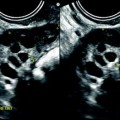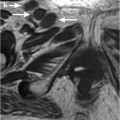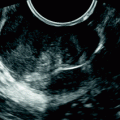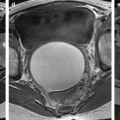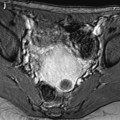Jean Noel Buy1 and Michel Ghossain2
(1)
Service Radiologie, Hopital Hotel-Dieu, Paris, France
(2)
Department of Radiology, Hotel Dieu de France, Beirut, Lebanon
Abstract
Hyperandrogenism is a clinical and biological syndrome secondary to an increase of secretion of androgens. These androgens can be produced by the cortex of the adrenal gland in its inner layer, the reticularis; by the ovary in the theca of the ovarian follicle, the stroma or the hilus Leydig cells; and in some cases, as in the PCOS, both in the ovary and in the adrenal gland.
Hyperandrogenism is a clinical and biological syndrome secondary to an increase of secretion of androgens. The androgens can be produced by the cortex of the adrenal gland in its inner layer, the reticularis; by the ovary in the theca of the ovarian follicle, the stroma or the hilus Leydig cells; and in some cases, as in the PCOD, both in the ovary and in the adrenal gland.
This hyperandrogenism has particular clinical and biological findings which can be isolated. Or it can be associated with clinical and biological findings of virilization.
In clinical practice:
1.
The adrenal or ovarian origin of these syndromes can be difficult to determine, leading sometimes to venous catheterization of the adrenal and the ovarian veins.
2.
The etiology, functional or tumoral, can be difficult to assess.
3.
As the ovarian etiologies are discussed in three different chapters of the book (Chaps. 7, 11, and 13), it seemed to us interesting to report in a chapter of synthesis the main clinical and biological findings of these syndromes, the site of secretion and the biochemistry of the synthesis in the different compartments of the ovary, and the overview of the most frequent etiologies.
14.1 Biosynthesis of Adrenal and Ovarian Androgens
Biosynthesis of adrenal and ovarian androgens is reported in the biochemistry chapter (Chap. 3).
14.2 Clinical and Biological Findings
The clinical and biological findings of hyperandrogenism without virilization are reported in Table 14.1.
Table 14.1
Clinical and biological findings of hyperandrogenism
1. Clinical findings |
Related to hyperandrogenism: hirsutism, acne, seborrhea |
Related to ovulatory dysfunction: oligomenorrhea, amenorrhea, sterility |
Related to insulinoresistance syndrome: diabetes, acanthosis nigricans |
2. Biological findings |
Delta 4 androstenedione significantly increased |
Testosterone slightly increased |
The clinical and biological findings of hyperandrogenism with virilization are reported in Table 14.2.
Table 14.2
Clinical and biological findings of virilization
1. Clinical findings |
Clitoromegaly |
Hoarse voice |
Androgyne morphotype |
2. Biological findings |
Testosterone >200 ng/ml |
Delta 4 androstenedione proportionally less increased |
14.3 Etiology
The causes of hyperandrogenism without virilization are mainly functional in origin, while most of the hyperandrogenism with findings of virilization (except hyperthecosis of the ovary) are tumoral in origin. The etiologies of these entities may lie mainly in the ovary and the adrenal gland (or the hypophysis which secretes ACTH). The most common ones are reported in Table 14.3.
Table 14.3
Etiology of hyperandrogenism
(A) Ovary |
1. Functional ovarian lesions |
